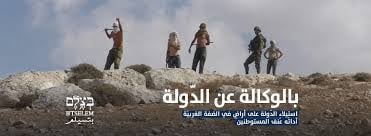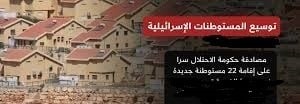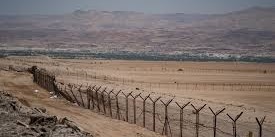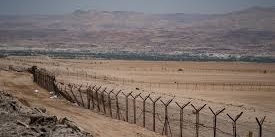By: Madeeha Al-A’raj
The National Bureau for Defending the Land and Resisting Settlements stated in its latest weekly report , that last April, Moh’d Awad Mosa, ambulance officer was driving from the village of Qaryut to the nearby the Al-Sawiya village to treat citizens, who were injured while confronting settlers, who were armed by Itamar Ben Gvir and attacked the village protected by their army to intimidate the Palestinians. Mosa was martyred by settlers’ bullets, and thus, his mission to help others sadly ended.. The occupation army and herds of settlers targeting medical teams is not new, and is an indication of the brutality and barbarism of the occupation with its soldiers and settlers, who easily pull the trigger and always escape punishment.
At the beginning of this year, within 2 days, the settlers committed horrific crimes, in which 3 citizens of the Qusra village, in the Nablus Governorate were killed, including children, and 13 others were injured by live bullets, during confrontations with the occupation army and settlers, who were not satisfied with this number. On the way from the hospital to this town, the settlers also attacked an ambulance that was carrying the martyrs, and 2 other citizens, who were accompanying the ambulances, were killed in that attack.
Within the context of the war on the Gaza Strip, the rate of settler violence increased, as they devised various means to practice violence and terrorism against Palestinian citizens. The Hebron Hills areas bear witness to the ceaseless violence of these settlers, who attack Palestinian shepherds. Sadda Al-Tha’ala is evidence of this, as the Bedouin community in that region is constantly exposed to unprecedented violence.
Recently, they attacked Palestinian citizens who were grazing their herds in the area, driving them out of the pastures, using drones to chase them and their livestock. This incident was not unique, insofar as organizations defending human rights, both Israeli and foreign, describe it as an economic war waged by settlers to push Palestinians to migrate from their pastures and areas.
This incident was one of 561 incidents of Israeli settler attacks against Palestinians, which were recorded by the UN’s Office for the Coordination of Humanitarian Affairs in the period between Oct. 7, 2023, and Feb. 20, 2024, in repeated attacks at the hands of settlers and members of the occupation army, which claimed the lives of 8 Palestinians, 111 injuries, and displacement of 1,208 Palestinians, including 586 children, from 198 families, according to the Office for the Coordination of Humanitarian Affairs’ database.
These examples of violence are not isolated incidents, as much as they are acts of brutality committed by terrorist settlers against the Palestinian population in the occupied West Bank in parallel with acts of genocide committed by the occupying army in the Gaza Strip. they enjoys the support of the occupation forces and the aid and abetment of the government. Settler violence, especially in light of the brutal war waged by the occupation forces on the Gaza Strip, has become a daily manifestation and an integral part of the state’s policy and its plan for ethnic cleansing in the occupied Palestinian territories, and enabling settlement expansion, even though the settlements are illegal under international law, as reported by international organizations working in the West Bank.
In the atmosphere of this brutal war on the Gaza Strip and the war crimes, crimes against humanity, and genocide that accompany it, the criminal activities of Jewish terrorist organizations have expanded, which take the settlements, outposts, and so-called pastoral farms as safe havens under the protection of the army and emergency teams, which were formed and armed by Ben Gvir. It went beyond burning Palestinian crops and trees, stealing their crops, destroying their water wells, preventing them from benefiting from their water springs, storming their homes in their towns and villages, blocking their roads, and throwing stones at their vehicles, and entered a new phase of organized terrorism using weapons and making it easy to pull the trigger, as their army does, until the number of martyrs reached more than 20, who have been killed by the fire of these settlers since the Oct. 7, after the settlements turned into armed arsenals and greenhouses for breeding terrorist ideology and forming organizations that turned into a force of pressure and aggression that defies, so to speak, even the measures that the occupation authorities resort to to keep the situation under control and absorb International reactions condemning settler violence.
The violence practiced by settlers in general and by terrorists in settlement outposts and so-called pastoral farms in particular has become part of the routine of life of these communities. Settlers’ violence takes many forms, such as, raids with small tractors or horses, running over livestock, grazing their herds in Palestinian fields, sabotaging agricultural crops, storming gathering areas in night robberies, stealing livestock, and sabotaging and burning property. The dividing line between the occupation forces and police in the West Bank and armed settlers has become clearly blurred, especially after the Minister of National Security, Itamar Ben Gvir, distributed thousands of firearms and other combat equipment to the settlers.
‘B’Tselem’ described settler violence as a form of state violence, through which Israel can ‘get two things at once’, it can claim that this violence is being committed by private individuals – a few ‘bad apples’. Among the settlers – and at the same time deny the role played by its security forces, while benefiting from the consequences resulting from this; that is, expelling the Palestinians from their lands.
The lack of accountability for settler violence in the Israeli courts – military or civil, indicates that the occupation authorities are not interested in putting an end to the terrorist practices of settler herds, even though their identities are known to the Israeli authorities. However, these crimes continue with impunity, as a recent study conducted by Israeli human rights organizations showed that between 2005 and 2023, the Israeli police closed about 93.7 percent of investigation files related to Israelis, who harmed Palestinians in the occupied West Bank.
The occupation authorities claim that settler violence has declined in times of war, while daily events confirm the opposite, after 57.5% of Palestinian victims of Israeli crimes chose not to file complaints due to a lack of confidence in the police, the occupation forces, and the so-called law enforcement agencies. At the same time, Israeli police’s statistics revealed that the punitive measures taken by the American Administration against a group of settlers’ field commanders; because of their attacks on Palestinians in the West Bank, which were followed by similar measures in France, Belgium, Britain and other EU’s states, didn’t affect settler activity.
Israeli journalist Amira Hass recently commented on examples of settler attacks, after about 30 settlers stormed the village of Mikhmas 45 days ago, in the evening hours of a Saturday, addressing the American president, saying, “Let the American president know that the weapon that the settlers used in their attacks on the Palestinians is an American weapon.” It is intended to spread terror, and he must know that many of the residents of this Palestinian town own fields and orchards, which they cannot reach due to the threat of armed settlers who have taken control of their lands.
In this context, last Thursday, the New York Times Newspaper revealed a document on the deliberations led by General Yehuda Fuchs, commander of the so-called central region in the West Bank, on March 20, which dealt with the lack of law enforcement on building in the settlements and leniency with terrorist settlers in the past decades. In the document, Fuchs criticized the “Settlement Directorate” established by the Minister of Settlement in the Army Ministry, Bezalel Smotrich, which has absolute control over the non-enforcement of the law against settlement construction without permission from the occupation authorities, and over the demolition of homes in Palestinian towns and villages.
According to the document, Fox confirms that “according to the Civil Administration’s data for the year 2023, there has been an increase in the number of illegal buildings built by Israelis throughout Judea and Samaria (the West Bank), in addition to an expansion in invading lands and constructing roads that were not on state lands.” That is, on lands under private Palestinian ownership. In some cases, new random settlement outposts were established, and in other cases, existing random settlement outposts were expanded.” And that directorate refrained from approving enforcement steps towards illegal Israeli construction.”
Regarding some aspects of the violence of the army and settlers, we cite 2 prominent examples to clarify the picture, the first from the Hebron Governorate and the second from the Nablus Governorate. In Saddat Al-Thoa’la, South Hebron Hills, while 8 shepherds from the Bedouin community in the area were grazing their flock on their private lands, accompanied by Israeli activists, eight soldiers arrived at the place in a military jeep, led by an officer known to the residents as a settler from the area.
They called the shepherds and activists and checked their identity cards. About ten minutes later, another military jeep arrived at the scene and stopped about 70 meters from the pasture land. A soldier got out of the jeep and flew a quad-copter over the herd, which panicked and dispersed, so the soldiers chased the herd. The shepherds tried to gather the frightened herd, but the soldiers started chasing them. The officer, known to the residents as a settler, detained the shepherds in the place. Meanwhile, the other shepherds were able to lead the herd to the field, but as a result of the panic, 11 goats died and 37 others miscarried. A short time later, a soldier known to the residents as a settler came to the gathering and presented to the shepherds a document declaring their pasture lands a closed military zone for 30 days.
Another example in the Khirbet Tana Community, east of the city of Nablus, after midnight, settlers riding in 15 cars and a number of soldiers, equipped with a bulldozer, came to the community, where at this season only part of the population was there. The settlers attacked the residents, handcuffed them, beat them, and insulted them. They injured one of them in the head and caused fractures in the ribs of another. They told the residents that they had to leave the place.
After detaining them for about an hour and a half, and then released them. The shepherds were forced to leave, but the settlers demolished all 25 residential tents of the 18 families in the community. The next morning, the residents tried to return to the community to take some of the sheep that remained in the place, but they discovered that the army had set up a roadblock and the soldiers at the checkpoint had refused to allow them to cross.
The goal behind this violence, which is practiced in cooperation between the occupying army and the settlers, is clear: it is displacement and ethnic cleansing, and to achieve this goal, settlers are putting pressure on the Palestinian Bedouin and herding communities in Area C, according to the agreements signed between the Palestinian and Israeli parties. Some of these communities were subjected to forced displacement, and others to partial, while other communities are threatened with the same fate.
The total forced displacement operations have so far affected 157 families, including about 1,100, including about 400 children, in Khallet al-Hamra, next to Kaysan and the Tuqu wilderness in the Bethlehem governorate, Khirbet Ain al-Rashash near the village of Duma in the Nablus Governorate, Khirbet Tana, Khirbet Jabait, and South al-Nusariya. In the Nablus Governorate, Wadi Al-Siq in the eastern slopes of the Ramallah Mountains, the Mleihat community, east of Ramoun and Ain Samiya, west of “Alon Street.” In the Ramallah Governorate, Khirbet Al-Taybeh – Tarqumiya, Khirbet Al-Radeem, South Hebron Hills, Atiriyah, South Al-Samou’, South Hebron Hills were killed. Muslim, south of Al-Samu’, South Hebron Hills, Khirbet Zanuta, South Hebron Hills, Anizan, South Hebron Hills, Al-Qanub, northeast of Sa’ir, Hebron Governorate and Hizma Wilderness, Jerusalem Governorate, and Ain Al-Sukhun in the Jordan Valley. Other communities that were partially displaced include Khirbet Susiya in the Hebron Governorate, the community south of Ain Shibli, Khirbet Samra and Naba` al-Ghazal in Al-Farisiyah, Khirbet Tal al-Himma in the northern Jordan Valley, and the Jibas Bedouin community east of Taybeh in the Ramallah Governorate.
As for the communities threatened with displacement, their number is about 12, most of them in South Hebron and Masafer Yatta in the Hebron Governorate, such as Khirbet Wadi Jahish, Mughair al-Ubaid, al-Mufaqara, Khirbet Sha’b al-Batm, Haribat al-Nabi, Khallet al-Daba’, al-Qawawis, al-Sarura, Umnizel, Khallet Taha, al-Jawaiya, Um Tir, Wadi al-Rakhim, Khallet Taha, Masafer Yatta, and the South Hebron Hills. Sha’ab al-Batman, Masafer Yatta, South Hebron Hills, Khirbet Um Nir, north of Khirbet Susya, Khirbet al-Safai al-Tahta, Haribat al-Nabi, Hills of Masafer Bani Na’im, Khirbet al-Tuba.
In addition to other communities. in the Palestinian Jordan Valley, especially the northern ones, such as, the Ihmir community, Khallet Khader, Khirbet Atuf, and Khirbet Al-Maleh, Khirbet Ain Al-Hilweh, Khirbet Wadi Al-Faw, Dhara’ Awad and Khallet Makhul, and in the Jericho Governorate, such as the Al-Ma’rajat Bedouin community east of ‘Mleihat’, Al-Hathura. This is Wadi al-Qilt, next to the east of Taybeh ‘Mu’rajat’ Bedouin’ – Dhahr al-Jabal, next to the monastery, as well as Wadi Qana in Salfeet Governorate and Wadi Abayat, near Kaisan in Bethlehem Governorate.
List of Israeli Assaults over the Last Week Documented by the National Bureau:
Jerusalem:
- Burning trees and grass in the vicinity of the headquarters of the UNRWA, located in the Sheikh Jarrah Neighborhood. UNRWA crews present at the headquarters responded to put out the fire and prevent it from spreading to the other headquarters’ buildings. UNRWA described that as “intimidation and sabotage.” International bodies, institutions and personalities condemned the sinful attack on the agency
Hebron:
- Demolishing the house of prisoner, Nadim Sabarneh in the Za’atah area in the Beit Umar town, claiming “building without a permit,” which is the excuse they use to demolish hundreds of Palestinian homes. It also demolished a house belonging to the citizen Ibrahim Mah’d Jamil Abu Maria, located in the Al-Mazara area, southeast of Beit Ummar, adjacent to Al-Aroub Camp, and the new bypass road.
- Attacking shepheds and farmers in the Maghfira village, assaulted them, and prevented them from reaching their pastures. Others gathered on the “Farsh al-Hawa” bypass road near the “Adora” settlement, west of Hebron, threw stones at citizens’ vehicles, and closed the street, causing material damage to a number of them.
- Destroying agricultural crops in the Khallet-Dabaa in the town of Yatta and released their livestock onto 40 dunums planted with seasonal winter crops, “wheat, barley,” causing damage. A group of settlers also stormed the house of citizen Muhammad Abd al-Rahman al-Jabareen, in the Sha’b al-Batm area in Masafer Yatta, searched it and tampered with its contents, and threatened its owner that they would storm it again.
- Seizing an agricultural tractor, owned by the citizen Moh’d Odeh Abd Rabbo, while he was working on his land. Settlers also kidnapped the elderly Jibreen Musa Al-Na’min while he was grazing his sheep in the Aqawawis area, Masafer Yatta and severely beaten him.
Bethlehem:
- Notifying a number of farmers to stop working on their lands without returning to them, in the Nahalin town, Bethlehem.
- Beating citizen, Kawkab Mustafa Ayesh, 50, from the village of Artas, Bethlehem, while she was on her land in Khallet al-Nahla, near the village of Wadi Rahal, which led to her suffering fractures in her hands and feet, then She admitted to a hospital in Bethlehem.
- Seizing a large quantity of wheat and barley crops from the lands of the village of Al-Minya in the area near the “dump” area, and attacked farmers and shepherds.
Ramallah:
- Setting fire to olive trees and agricultural crops in the village of Al-Mughayir and burned the trees and crops, protected by the occupation forces, and firing at citizens, who approached the place to try to extinguish the fires.
- Storming the outskirts of the town Sinjil, and attacked a house and a vehicle parked in front of it, smashed its windows, while the occupation army and settlers stormed the Al-Batin area opposite Jabal Al-Alam in Ni’lin and arrested, Abdullah Sorour, 32 while he was working on plowing his land and seized his agricultural tractor under the pretext of working in an area C.
Nablus:
- Storming a water spring in the Qariot village, and performed Talmudic rituals at the place.
- Burning an uninhabited house belonging to citizen, Fathi Dawabsha and wrote racist slogans stressing revenge.
- Attacking the entrance of the Qusra town, injuring a youth by live bullets in the same town, during an attack by dozens of settlers from the “Yesh Kodesh” outpost, others beaten up a street vendor at the entrance to the village of Bazaria.
- Assaulting two young men, Muhannad Issam Khalil and Ali Hassan Younis from the Majdal Bani Fadel village, and they were subsequently detained by the occupation forces, while settlers, protected by the occupation army, attacked a house on the outskirts of the Burqa town and burned a vehicle parked in front of it belonging to the citizen Suleiman Daghlas. They also burned an agricultural room near the western entrance to the archaeological area in the Sebastia town.
Jordan Valley: Storming the “Arab Al-Malihat Bedouin community’ northwest of Jericho, conducted searches in citizens’ houses, counted the number of livestock in the community, created an atmosphere of fear among children and women, others set fire to rain-fed Palestinian crops, destroyed 3 houses under construction belonging to the Al-Kharabsheh’s family – Arab-Rashayda, near the Nuweimah village, Jericho
 المكتب الوطني للدفاع عن الارض ومقاومة الاستيطان منظمة التحرير الفلسطينية
المكتب الوطني للدفاع عن الارض ومقاومة الاستيطان منظمة التحرير الفلسطينية




